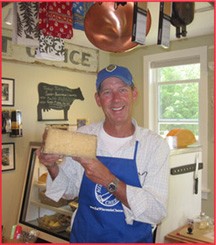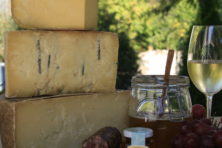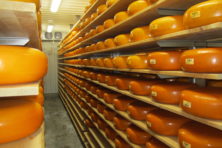The Cheese Insider
- Share
- Tweet
- Pin
- Share
One of my favorite styles of cheeses is commonly known as “Alpine Style.” This family of cheeses originated in the Alps of Switzerland and eastern France. The remote villages of this mountainous region had very little tillable land in the valleys, but did have lush alpine meadows, and an abundant fresh water supply, perfect for grazing cows in the summer months. The herdsman/cheesemakers take the cows into the mountains in the spring, and make cheese all summer. In the fall they bring the cows and the cheese they have been making, back down the mountains for the winter. Well known examples of this style of cheese are: Emmentaler (Swiss), Gruyere, Appenzeller, and Beaufort. Alpine cheeses are typically washed rind, with a hard surface, and a nutty flavor. This style of cheese is more durable and can endure the long trips out of the mountains in the fall.
The high quality alpine style cheeses made here in Wisconsin include Pleasant Ridge Reserve of Uplands Cheese in Dodgeville, Emmentaler (big wheel Swiss) of Edelweiss Creamery in Monticello, Alpine Renegade from Bleu Mont Dairy in Blue Mounds, and the recently, Little Mountain from Roelli Cheese in Shullsburg. All four of these cheeses are made with grass fed cows milk in the tradition of European alpine style cheesemaking.
The cows that produce the fine alpine cheeses in Europe are generally smaller and a bit more athletic, bred to walk up and down the steep hills of the Alps. The milk produced by this herd is one of the things that make their cheese so unique. The cheese is made only when the pastures produce enough for the cows to eat. Once the milk is turned into cheese the work just begins.
The wheels of cheese are rubbed, by hand, with salt and washed with brine every day for the first 30 days of curing. Then it is every other day that the wheels are washed, by hand, with natural bacteria, creating a rind on the surface of the cheese. This rind is what protects the cheese and allows it to age for up to 18 to 24 months. Throughout the aging process one wheel from every batch, is used to test the cheese. The cheesemaker will take core samples, using a device called a tryer, from the wheel to determine how the cheese is aging, and the flavor profiles he is looking for. Each day that the cheesemaker makes cheese the milk is slightly different from the day before, because the cows are in a different pasture, and are subject to different weather conditions.
Our cheesemongers get asked all the time, “What makes it an artisan cheese?” The skill, hard work, and careful planning in making a cheese like the four cheeses mentioned above are good examples of what we like to share with our customers.
Michael C. Thomas is co-owner of Schoolhouse Artisan Cheese with his wife Janice. With locations in Ellison Bay and Egg Harbor, they aim to bring the best of Wisconsin artisan cheeses to Door County, and with “The Cheese Insider” Michael hopes to bring all things cheese to readers of the Pulse.





